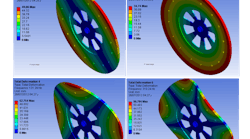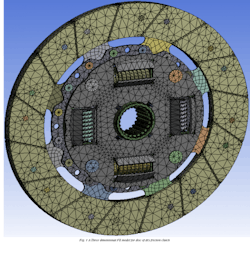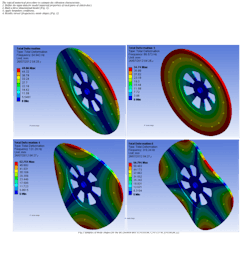Clutches intermittently engage machines drives with driven parts. They’re used extensively in industrial machinery as well as in passenger vehicles where they connect engines to gearboxes. For the latter application, cars must deliver a comfortable ride — so smooth engagement is the ultimate task for automatic transmissions. That means their clutches must transmit as little jerk as possible when they engage and disengage. Most automobiles’ automatic transmissions use dry-friction clutches because they’re generally the most efficient clutch option. Here, the main threat to the clutch discs is excessive heat in the frictional lining.
During slipping, friction surfaces are at risk of damage from high thermal stresses. If slipping is bad enough, it accelerates the rate of wear. The pressure distribution between the engaging surfaces changes and becomes increasingly concentrated — so that eventually, the area of contact is smaller than the clutch’s nominal contact area.
At this point, plastic deformation of the friction material occurs, and hotspots appear on the contact surfaces thanks to asperity, focal, distortional, and regional forms of degraded contact. Inefficiency and noisiness ensues.
There’s another problem almost as dangerous as high heat during slipping — vibrations through the power transmission. They degrade ride quality. They put excessive stress power-transmission components and speed the wear of contacting surfaces. The worst-case scenario is when inputs excite resonant frequencies and induce large-amplitude moves that can quickly cause the clutch disc to fail.
At first, vibrations just degrade a vehicle’s ride comfort. Next, the clutch performance slips. Then the clutch fails. That’s why it’s essential to use numerical simulation to get sufficient information about the clutch disc’s dynamic behavior — including the range of safety frequencies and the effect of geometric design parameters and material properties on the disc’s dynamic behavior.
Finite-element analysis (FEA) accurately models
vibration characteristics of the clutch disc
There are four steps to using FEA to model the vibration characteristics of a clutch.
1. Define the input data for the model, including material properties for each part of clutch disc.
2. Built a three-dimensional model. For example:
3. Next, apply boundary conditions.
4. Finally, review the results in a viewer to identify critical frequencies and mode shapes.
Shown above are the mode shapes of a sample clutch disc. The mode shapes have values:
ri = 0.085 m
ro = 0.135 m
tf = 0.002 m.
In fact, these simulation results recently helped engineers design a friction clutch disc suitable for a specific vehicle transmission.
References:
Oday Abdullah’s profile at the Universität Hamburg-Harburg website
Abdullah, Oday I., and Josef Schlattmann — "Effect of Band Contact on the Temperature Distribution for Dry Friction Clutch." Proceeding of World Academy of Science, Engineering and Technology Conference, Berlin, 2012
Abdullah, Oday I., and Josef Schlattmann. "Vibration Analysis of the Friction clutch Disc Using Finite Element Method." Advances in Mechanical Engineering and its Applications 1.4 (2012): 86-91.


